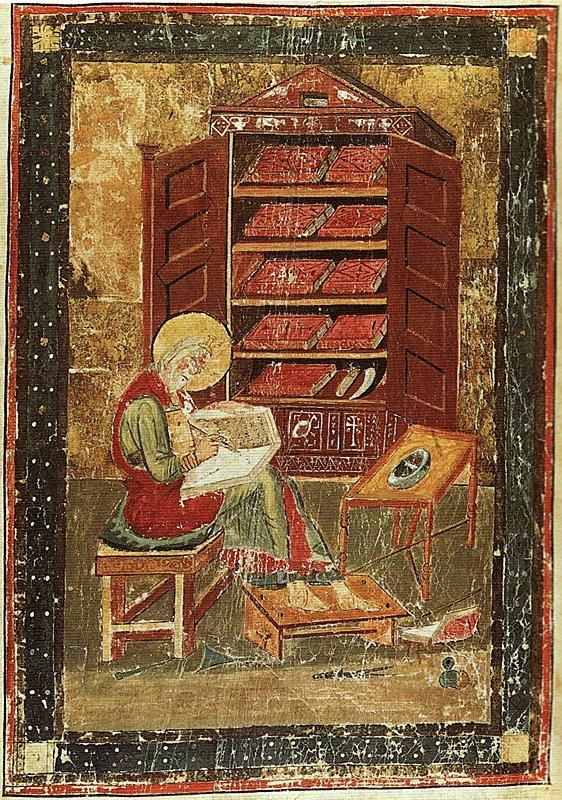Liane M. Feldman, “Story and Sacrifice: Ritual, Narrative, and the Priestly Source,” PhD Dissertation, University of Chicago, 2018.
Read MorePaul, the Gentiles, and the Other(s) in Jewish Discourse
The Apostle Paul in St. Sophia of Kyiv via Wiki Commons.
The Apostle Paul in St. Sophia of Kyiv via Wiki Commons.
Cavan Concannon responds to Adi Ophir and Ishay Rosen-Zvi’s book, Goy: Israel’s Multiple Others and the Birth of the Gentile in the AJR review forum.
Read MoreThe Goy: A Synchronic Proposal
“Moses receiving the law” in the Basilica of San Vitale is a church in Ravenna, Italy,
“Moses receiving the law” in the Basilica of San Vitale is a church in Ravenna, Italy,
Christine Hayes responds to Adi Ophir and Ishay Rosen-Zvi’s book, Goy: Israel’s Multiple Others and the Birth of the Gentile in the AJR review forum.
Read MoreEthnic and Cultural Identities in the Rabbinic Goy Discourse
Isaac, Jacob, and Esau at Cathedral of Monreale, Italy via Wiki Commons.
Isaac, Jacob, and Esau at Cathedral of Monreale, Italy via Wiki Commons.
Yair Furstenberg responds to Adi Ophir and Ishay Rosen-Zvi’s book, Goy: Israel’s Multiple Others and the Birth of the Gentile in the AJR review forum.
Read MoreThe Perils of Polarization
Cynthia Baker responds to Adi Ophir and Ishay Rosen-Zvi’s book, Goy: Israel’s Multiple Others and the Birth of the Gentile in the AJR review forum.
Read MoreGoy: An AJR Forum
The AJR review forum of Adi Ophir and Ishay Rosen-Zvi’s book, Goy: Israel’s Multiple Others and the Birth of the Gentile. With responses from Cynthia Baker, Yair Furstenberg, Christine Hayes, and Cavan Concannon.
Read MoreWhy Goy?
Adi Ophir and Ishay Rosen-Zvi open the AJR review forum of their book, Goy: Israel’s Multiple Others and the Birth of the Gentile.
Read MoreBook Note | The Origins of Midrash
Week in Review (2/8/19)
Ca. early fourth-century painting of a woman | Catacomb of Calixtus, Rome | Image Source
Ca. early fourth-century painting of a woman | Catacomb of Calixtus, Rome | Image Source
This Week: Hypatia, translational twists and turns, Job and reparations, the problem with “Judeo-Christian,” JQR behind-the-scenes, Cairo Genizah – and more!
Read MoreAffect and Early Christian Identity
Papers from the 2018 Society of Biblical Literature’s review panel on Maia Kotrosits’s Rethinking Early Christian Identity: Affect, Violence, and Belonging (Fortress, 2015).
Read MoreJob, White Privilege, and the Case for Reparations
Nevertheless, I characterize the book as more protean. It resists reductive readings, always offering a counter-text to any interpretation (including the one in this essay.)
Read MoreBook Note | Hypatia: The Life and Legend of an Ancient Philosopher
Watts ends the volume with a chapter on such modern representations of Hypatia, which move already suggests his aim: to bracket the legend long enough to catch sight of the life that inspired it.
Read MoreDissertation Spotlight | Magical Practices and Discourses of Magic in Early Christian Traditions: Jesus, Peter, and Paul
I argue one must take into account not only what magic is said to be, but also what magicians do. There is a reason, after all, that these practices are the ones against which Apuleius was compelled to mount his defense.
Read MoreRethinking Early Christian Identity: A Response
Maia Kotrosits responds to the review forum on Rethinking Early Christian Identity: Affect, Violence, and Belonging (Fortress, 2015).
Read MoreWeek in Review (1/25/19)
Catacomb painting, possibly of Eucharist bread | Catacomb of San Callisto, third century | Image source
Catacomb painting, possibly of Eucharist bread | Catacomb of San Callisto, third century | Image source
This Week: Continuing forum on early Christian identity, restoring Tutankhamen’s tomb, digital archaeology, Cairo Genizot, catacombs – and more!
Read MoreRethinking “Early Christian Art”
Jonah being thrown into the Sea. Catacomb of Saint Peter and Saint Marcellino, Rome, Italy, via wikicommons.
Jonah being thrown into the Sea. Catacomb of Saint Peter and Saint Marcellino, Rome, Italy, via wikicommons.
Eric Smith responds to Maia Kotrosits’s Rethinking Early Christian Identity: Affect, Violence, and Belonging (Fortress, 2015).
Read More"What Has Affect Theory to do with Acts?": Testing Methodological Boundaries In Acts Scholarship
Teresa Calpino responds to Maia Kotrosits’s Rethinking Early Christian Identity: Affect, Violence, and Belonging (Fortress, 2015).
Read MoreWeek in Review (1/18/19)
Wax encaustic funerary painting on wood | Second-century Roman Egypt, in the collection of the Badisches Landesmuseum (Karlsruhe) | Image Source
Wax encaustic funerary painting on wood | Second-century Roman Egypt, in the collection of the Badisches Landesmuseum (Karlsruhe) | Image Source
This Week: New forum complicating early Christian identity with Maia Kotrosits, forgery, Roman-era Egyptian tombs, museum ethics – and more!
Read MoreThe Codex of Feeling: Affect Theory and Ancient Texts
Donovan Schaefer responds to Maia Kotrosits’s Rethinking Early Christian Identity: Affect, Violence, and Belonging (Fortress, 2015) at the 2018 SBL review panel.
Read MoreEngaging with Intersectionality and 1st-2nd c. "Judaism"
Shayna Sheinfeld responds to Maia Kotrosits’s Rethinking Early Christian Identity: Affect, Violence, and Belonging (Fortress, 2015) at the 2018 SBL review panel.
Read More

















